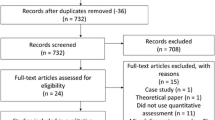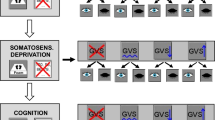Abstract
First-generation H1-antihistamines are known to cause fatigue and drowsiness, due to their poor receptor selectivity and their high penetration rate of the blood–brain barrier. However, little is known about the effects of first-generation H1-antihistamines on postural stability. The purpose of this study was to evaluate the effects of d-chlorpheniramine on postural stability using posturography with and without foam rubber. A double-blind study with three parallel groups was conducted. Twenty-seven healthy young volunteers (mean age 21.9 years) were recruited and orally administered d-chlorpheniramine, 2 or 4 mg, or placebo. Postural sway was measured every hour up to 8 h after administration. Two-legged stance tasks were performed by each subject in four conditions: eyes open or eyes closed and with or without foam rubber. Inter-group comparisons showed that the group receiving 4-mg d-chlorpheniramine showed significantly larger sway in the eyes open with foam rubber condition (visual and vestibular information available, somatosensory information reduced). Inter-subject analysis in the 4-mg d-chlorpheniramine group showed that the effect of d-chlorpheniramine on postural control was variable. Our results suggest that among the three main sensory systems responsible for postural control (visual, vestibular, and somatosensory), d-chlorpheniramine may have a larger effect on the visual and/or vestibular systems in susceptible individuals.




Similar content being viewed by others
References
Akabane H, Shimada Y, Ogawa R (2004) Usefulness of posturography after epidural block. J Nippon Med Sch 71:35–43
Baloh RW, Honrubia V (2001) Clinical neurophysiology of the vestibular system. Oxford University Press, New York
Bense S, Stephan T, Yousry TA, Brandt T, Dieterich M (2001) Multisensory cortical signal increases and decreases during vestibular galvanic stimulation (fMRI). J Neurophysiol 85:886–899
Botta L, Tritto S, Perin P et al (2008) Histamine H1 receptors are expressed in mouse and frog semicircular canal sensory epithelia. NeuroReport 19:425–429
Brandt T, Bartenstein P, Janek A, Dieterich M (1998) Reciprocal inhibitory visual-vestibular interaction. Visual motion stimulation deactivates the parieto-insular vestibular cortex. Brain 121 (Pt 9):1749–1758
Bronstein AM, Guerraz M (1999) Visual-vestibular control of posture and gait: physiological mechanisms and disorders. Curr Opin Neurol 12:5–11
Cavanaugh JT, Mercer VS, Stergiou N (2007) Approximate entropy detects the effect of a secondary cognitive task on postural control in healthy young adults: a methodological report. J Neuroeng Rehabil 4:42
Church MK, Maurer M, Simons FE et al (2010) Risk of first-generation H(1)-antihistamines: a GA(2)LEN position paper. Allergy 65:459–466
Costa M, Goldberger AL, Peng CK (2002) Multiscale entropy analysis of complex physiologic time series. Phys Rev Lett 89:068102
Dai M, Kaufmann H, Raphan T, Cohen B (2000) Promethazine affects optokinetic but not vestibular responses in monkeys. Aviat Space Environ Med 71:1003–1012
Dieterich M (2007) Functional brain imaging: a window into the visuo-vestibular systems. Curr Opin Neurol 20:12–18
Dong X, Yoshida K, Stoffregen TA (2011) Control of a virtual vehicle influences postural activity and motion sickness. J Exp Psychol Appl 17:128–138
Eickhoff SB, Weiss PH, Amunts K, Fink GR, Zilles K (2006) Identifying human parieto-insular vestibular cortex using fMRI and cytoarchitectonic mapping. Hum Brain Mapp 27:611–621
Fujimoto C, Murofushi T, Chihara Y et al (2009) Assessment of diagnostic accuracy of foam posturography for peripheral vestibular disorders: analysis of parameters related to visual and somatosensory dependence. Clin Neurophysiol 120:1408–1414
Fujimoto C, Murofushi T, Chihara Y, Ushio M, Yamaguchi T, Yamasoba T, Iwasaki S (2010) Effects of unilateral dysfunction of the inferior vestibular nerve system on postural stability. Clin Neurophysiol 121:1279–1284
Furman JM (1995) Role of posturography in the management of vestibular patients. Otolaryngol Head Neck Surg 112:8–15
Hindmarch I, Shamsi Z, Kimber S (2002) An evaluation of the effects of high-dose fexofenadine on the central nervous system: a double-blind, placebo-controlled study in healthy volunteers. Clin Exp Allergy 32:133–139
Ledin T, Odkvist LM, Moller C (1995) Effects of loratadine on postural control. Acta Otolaryngol Suppl 520(Pt 2):310–312
Lin E, Aligene K (2013) Pharmacology of balance and dizziness. NeuroRehabilitation 32:529–542
Massion J, Alexandrov A, Frolov A (2004) Why and how are posture and movement coordinated? Prog Brain Res 143:13–27
Nicholls J (2001) From neuron to brain. Sinauer Associates, Massachusetts
Patel M, Fransson PA, Johansson R, Magnusson M (2011) Foam posturography: standing on foam is not equivalent to standing with decreased rapidly adapting mechanoreceptive sensation. Exp Brain Res 208:519–527
Paton DM, Webster DR (1985) Clinical pharmacokinetics of H1-receptor antagonists (the antihistamines). Clin Pharmacokinet 10:477–497
Peng CK, Havlin S, Stanley HE, Goldberger AL (1995) Quantification of scaling exponents and crossover phenomena in nonstationary heartbeat time series. Chaos 5:82–87
Pincus SM (1991) Approximate entropy as a measure of system complexity. Proc Natl Acad Sci USA 88:2297–2301
Rhea CK, Silver TA, Hong SL, Ryu JH, Studenka BE, Hughes CM, Haddad JM (2011) Noise and complexity in human postural control: interpreting the different estimations of entropy. PLoS ONE 6:e17696
Rumore MM (1984) Clinical pharmacokinetics of chlorpheniramine. Drug Intell Clin Pharm 18:701–707
Simons FE (2004) Advances in H1-antihistamines. N Engl J Med 351:2203–2217
Stergiou N, Buzzi U, Kurtz M, Heidel J (2004) Nonlinear tools in human movement. In: Stergiou N (ed) Innovative analyses of human movement. Human kinetics, pp 63–90
Tagawa M, Kano M, Okamura N et al (2001) Neuroimaging of histamine H1-receptor occupancy in human brain by positron emission tomography (PET): a comparative study of ebastine, a second-generation antihistamine, and (+)-chlorpheniramine, a classical antihistamine. Br J Clin Pharmacol 52:501–509
Tashiro M, Sakurada Y, Mochizuki H et al (2008) Effects of a sedative antihistamine, d-chlorpheniramine, on regional cerebral perfusion and performance during simulated car driving. Hum Psychopharmacol 23:139–150
Veldhuis JD, Keenan DM, Pincus SM (2008) Motivations and methods for analyzing pulsatile hormone secretion. Endocr Rev 29:823–864
Wang JJ, Dutia MB (1995) Effects of histamine and betahistine on rat medial vestibular nucleus neurones: possible mechanism of action of anti-histaminergic drugs in vertigo and motion sickness. Exp Brain Res 105:18–24
Acknowledgments
This work was supported in part by a grant from the Japanese Ministry of Education, Culture, Sports, Science and Technology (C-20791181). We would also like to acknowledge Mr. Hitoshi Murase in ANIMA Corp (Japan) for the technical support.
Conflict of interest
The authors declare that they have no conflicts of interest.
Author information
Authors and Affiliations
Corresponding author
Rights and permissions
About this article
Cite this article
Chihara, Y., Sato, A., Ohtani, M. et al. The effect of a first-generation H1-antihistamine on postural control: a preliminary study in healthy volunteers. Exp Brain Res 231, 257–266 (2013). https://doi.org/10.1007/s00221-013-3675-1
Received:
Accepted:
Published:
Issue Date:
DOI: https://doi.org/10.1007/s00221-013-3675-1




